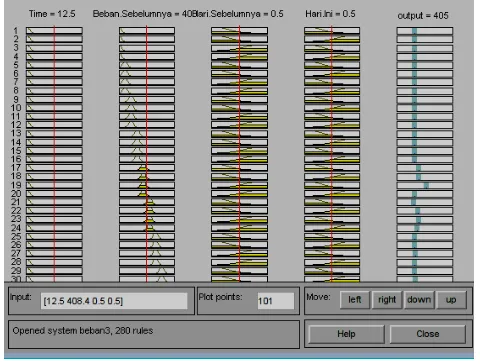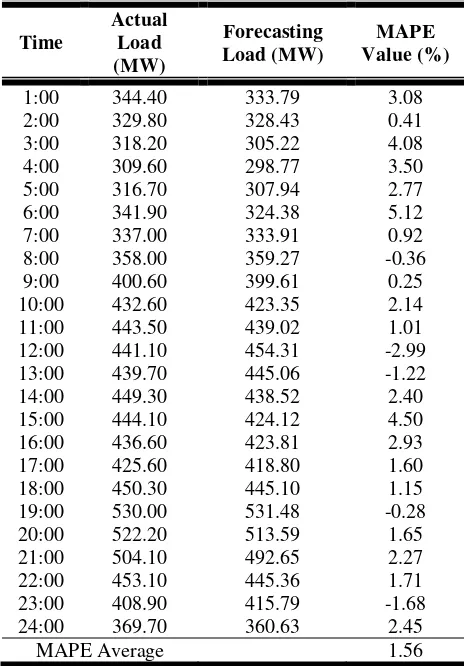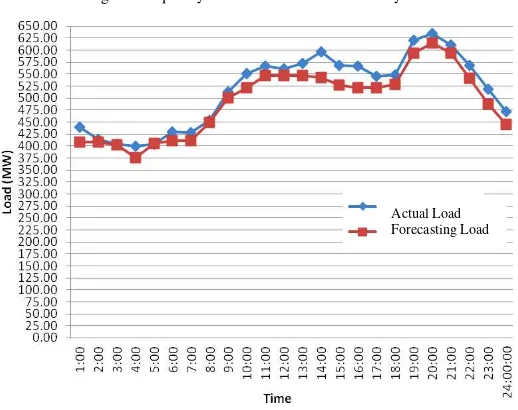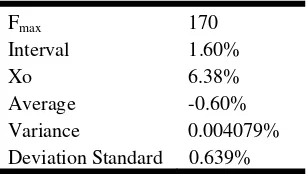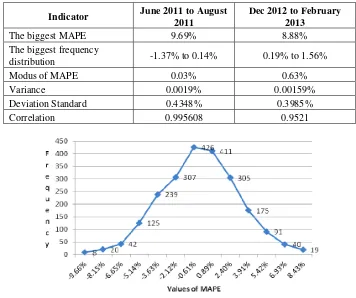Hourly Load Forecasting of Electricity in
Bali, Indonesia using Adaptive Neuro Fuzzy
Inference System
R.S. Hartati #1, Linawati *2, Widia Meindra S. #3
Electrical Engineering Department, Udayana University, Bali, Indonesia
1 [email protected] 2 [email protected]
Abstract—Today electricity has been basic need for economical growth. One of measurement to identify electricity capacity in an area or a country is electricity consumption index per capita. The index in Bali, Indonesia is still lower than other developing countries in Asia. Therefore load forecasting of electricity in Bali is required to yield good electricity capacity planning. Thus this paper investigates accuracy of ANFIS implementation on forecasting electricity consumption hourly. The accuracy is characterized by MAPE, modus of MAPE, variance of MAPE, and its correlation. All the results confirm that ANFIS model is sufficient as short term electricity load predictor.
Keyword- Electricity, Load forecasting, ANFIS
I. INTRODUCTION
In modern era, demand of electricity in Indonesia especially in Bali keeps increasing, as the economy and prosperity in Bali are growing. Hence the demand should be anticipated by providing good quality and sufficient capacity of electricity. This demand will increase as electricity consumption index per capita in Bali is low, at 796 kWh, compared to other developing countries in Asia, that’s index achieves 1100 kWh. To fulfill the need both in capacity and quality, therefore good electricity generating planning is needed. The planning itself needs forecasting of electricity demand. The planning includes load forecasting on peak load in Mega Watt and demand forecasting in MWh. In time series, the planning can be categorized as short term forecasting, mid-term forecasting, and long-term forecasting.
ANFIS (Adaptive Neuro Fuzzy Inference System) is one of many methods that has been used to forecast electricity load [1-5]. The method applies error back propagation which has some benefits in convergence factor and its sensitivity to parameters corrections. Thus ANFIS has been applied widely to model and predict data in many fields. For instances, in finance, ANFIS has been used to predict loan payment based on analysis of customers payment planning [6]. The prediction gives collectability value accurately. In control system, ANFIS could handle complex and non linear system and changes in time by the use of learning algorithm of numerical data in system. ANFIS has been used to predict Heat Exchanger [7] where error output model is less than 2%. Moreover the research on speed control of servomotor MS150DC using ANFIS has been analyzed in [8]. ANFIS controlled the speed of the motor according to the motor load. Response of the motor speed was good with minimum error when steady state was achieved, even there was overshoot. Finally modified ANFIS to identify inductive motor speed has been applied in [9]. The motor speed control with vector control method without speed sensor was developed and tested. Then the speed was estimated using modified ANFIS method. The modification was done using lead square estimator on forward learning and steepest descent on backward learning. The simulation results that the modified ANFIS can estimate the speed with error estimation standard.
Hence short term load forecasting of electricity consumption using ANFIS will be investigated in this study. The short term forecasting is limited to hourly and daily forecast. This forecast is important for real-time control and safety control of energy management system. Data which is collected and used in this study is actual data from PT. PLN (Government Electricity Company) of Bali Distribution. The data used is from June 2011 until August 2011 and data from December 2012 until February 2013.
II. ELECTRICITY LOAD FORECASTING
Neural network with back propagation application was used to conduct long-term electricity load forecasting in Indonesia [3]. The method was used to predict peak load which applied economical data, such as bruto domestic product per capita, population number, household number, electrification ratio, CO2 pollution index,
average price of oil, average price of coal, total energy consumption, energy usage in industry sector, and average price of electricity. Ten years of actual data from year 1990 until 2000 have been used. The study found that forecast results are closed to the forecast of PT. PLN document of National Electricity Planning.
Kohonen method and counter propagation with Kohonen method. They process 3684 actual electricity load data in Mega Watt. The study found that the back propagation method produced more accurate prediction than the counter propagation with Kohonen method. On the other hand Elman-Recurrent Neural Network (RNN) was proposed by [10] to predict hourly electricity load demands in Mengare, Gresik, Indonesia. The study compared four different architectures of RNN, which is found that Elman-RNN(22,3,1) is the best method. Moreover the study in [11] investigated forecasting of short term electrical load using an approach of integrated neuro-fuzzy-wavelet. Both wavelet and ANFIS were applied to extract the featured coefficients from data and to do trend forecast of the wavelet coefficients.
Brief explanation over various methods for forecasting electricity demands is presented in [12]. Several classical models were applied for short-term, medium-term and long-term load forecasting, for examples regression-based methods, time series methods, state space models and Kalman-filtering. Other methods that are described in this paper are computational intelligence, vector regression, and hybrid approaches. The selection of proper method is crucial for decision making to face, for instance deregulation of energy markets. The paper [13] addresses Holt-Winters exponential smoothing technique and the time series analysis for forecasting the hourly electricity load curve of the Italian railways. The paper has demonstrated the exactness of the two models and the application of forecasting inside public utilities. More result is that the Holt-Winters model performs better than the ARIMA model as the standard deviation is 6.6% for the Holt-Winter case and 7.6% for the ARIMA model.
Furthermore Pattern Sequence Similarity with Neural Networks (PSF – NN) that is part of time series forecasting, is presented in [14]. The PSF – NN was chosen to perform electricity load forecasting of an interval of future values simultaneously, i.e. the 24 demands for the next day. A time series of hourly electricity demands for the state of New South Wales in Australia for three years was applied to evaluate the PSF-NN performance. Daily performance results which were indicated using MAPE, were ranging from 3.37% up to 4.51%. Then the investigation of the monthly performance of the method produced the best MAPE of 2.19% on March. However on December showed the worst MAPE of 9.93%. Finally the paper encourages the improvement of a hybrid switch approach for increasing the prediction accuracy.
Investigation of the merge of neural network and fuzzy logic or ANFIS for weekly electricity load forecasting is accomplished in [5]. Electricity load consumption data in year 2010 from the RTE France was applied to investigate the performance of the proposed method. The main purpose using the method is to reduce time consuming and complexity of existing model based on large scale of data. The study demonstrated that ANFIS produces good accuracy on weekly load consumption prediction. The performance of the proposed model was not affected by rapid fluctuations in power demand.
III.ANFIS METHOD
The steps using ANFIS in this study is below. Firstly is to collect and identify training set data, then to set up a network with five layers of ANFIS. Thirdly is to do learning process and simulation of load forecasting. Data is then categorized into some criteria and parameters. The criteria are all factors which are related to the short term load forecasting, i.e. time and loads. The parameters which belong to the criteria are reflected membership function of fuzzy. There are seven parameters in this process, namely midnight (MID.NIG), sun-rice time (DAWN), morning (MOR), noon (F.NOON), afternoon (A.NOON), evening (EVEN), and night (NIGHT). Electricity load has ten parameters, namely very very low (V.V.LOW), very low (V.LOW), low (LOW), quite normal (M.NORM), normal (NORM), up-normal (AB.NORM), high (HIGH), very high (V.HIGH), very very high (V.V.HIGH), and extremely high (E.HIGH) as shown in Figure 1. The load measurement data varies from 276 MW to 540.7 MW. On the other hand, simulation is set to two parameters, i.e. working day and weekend. The load pattern on working day and on weekend can be identified. Even though the load changes every day, the load variation can be grouped to be the load pattern of working day and the load pattern of weekend.
The simulation model follows three phases, starting with fuzzification phase, then interfacing phase, and defuzzification as the final phase. The model implemented in Matlab is to develop Fuzzy Inference System (FIS) with the first order Takagi – Sugeno with function membership of time and load history data. Amounts of each membership function are 7, 10, 2, and 2. Time membership function has seven parameters as mentioned above, from midnight (MID.NIG) until night (NIGHT) as seen in Figure 2. Working day and weekend are membership function of days as seen in Figure 3.
Fig.2. Time Membership Function
Fig.3. Days Membership Function
The membership function of time has 7 parameters, 10 parameters for load membership function, and 2 parameters for the day membership function. Thus amount of simulation rules from all the parameters are 280. The example of rule base for forecasting is displayed in Figure 4.
Fig. 4. ANFIS Rule base for Electricity Load Forecasting
On the training of FIS phase, ANFIS method provides two methods of optimization of membership function parameter, specifically Back propagation and Hybrid methods. The Hybrid method combines back propagation and least square processes. This study used the Hybrid as a training system. Error tolerance value is chose to
Working Day
Plot Points Membership function plots
stop the training process. In this training process, the error tolerance is set zero (default value). Then the simulation result of load prediction is tested and compared with the actual data. The accuracy of the results is stated in MAPE (Mean Absolute Percentage Error). Moreover the study results display statistical analysis of the forecasting such as modus, frequency distribution, variance, and correlation.
IV.RESULTS OF LOAD FORECASTING
The simulation result which is shown in Table 1 proves that hourly forecasting load is closed with the actual load. MAPE values are varies from 0.24% to 5.92%. The forecasting is done for 24 hours daily.
The biggest error in term of MAPE on June 2011 was on 9th June 2011 at 02:00 AM, i.e. 9.92%. This value is
better than forecasting the load using the methods in [1, 2] as shown in Figure 5. From the Figure 5, it is seen that on 24 hours the consumption is fluctuative and the consumption on night time is bigger than day time. The load reached its peak at 19.00. Therefore the error occurs because of the variation of electricity consumption.
Fig. 5. Hourly Electricity Load on 9th June 2011
In total, the forecasting process involved 720 data on June 2011 with the biggest frequency distribution of MAPE values located between -0.82% and 0.78% (around 170 times). This is 23.61% of total values. Figure 6 – Figure 9 display the distribution of MAPE on June 2011, July 2011, and February 2013. The biggest MAPE is 9.69% which happened on 15th July 2011 at 06:00. The biggest average of MAPE is 5.62% which happened on 14th July 2011. These values still produced better accuracy than the results using back propagation artificial network method in [1, 2]. Especially on July 2011, the consumption was higher than June 2011, since July was categorized as peak season for tourism. Then modus is calculated to find the largest amount of the frequency. Table 2 shows that the modus value of MAPE is -0.43%. It implies that the forecasting using ANFIS is accurate as the most frequent error is very small, i.e. 0.43.
Fig. 6. Frequency Distribution of MAPE on June 2011
Fig. 7. Frequency Distribution of MAPE on July 2011
Fig. 8. Hourly Electricity Load on 14th February 2013
Fig. 9. Frequency Distribution of MAPE on February 2013
TABLE II. MAPE Modus of June 2011
Parameter Value
fmo 170
Lmo -0.82%
f1 155
f2 124
I 1.60% Modus -0.43% Where:
fmo : class of frequency which contains modus
Lmo : the lowest value of the class
f1 : upper class of frequency
f2 : lower class of frequency
I : the class interval
In order to elaborate the accuracy of the ANFIS method in forecasting hourly electricity load, the deviation standard and variance to check the load variation and its homogeny. Table 3 demonstrates deviation standard and variance of MAPE of June 2011. The variance is 0.004079% and the deviation is 0.639%.
TABLE III. Deviation Standard and Variance of MAPE of June 2011
Fmax 170
Interval 1.60% Xo 6.38% Average -0.60% Variance 0.004079% Deviation Standard 0.639%
TABLE IV. Performance Evaluation of Hourly Forecasting
Indicator August
2011 Dec 2012 Jan 2013 Feb 2013
The biggest MAPE 9.2% 8.79% 8.86% 8.88% The biggest average of
MAPE 4.21%. 4.91% 4.88% 4.87% The biggest frequency
distribution
0.15% to 1.80%
0.28% to 1.88%
-3.12% to 1.56%
3.70% to 5.26% Modus of MAPE 0.53% 0.83% -2.03% 4.92%.
Variance 0.0041% 0.00393% 0.0038% 0.0044% Deviation Standard 0.6372%. 0.627% 0.6142% 0.6616%.
Correlation 0.9947 0.9587 0.934 0.9616 Then the study continues to evaluate MAPE values for three months, starting from June 2011 to August 2011.
Total data is 2,208.
TABLE V. Performance Evaluation of Hourly Forecasting Every Three Months
Indicator June 2011 to August
2011
Dec 2012 to February 2013
The biggest MAPE 9.69% 8.88% The biggest frequency
distribution -1.37% to 0.14% 0.19% to 1.56% Modus of MAPE 0.03% 0.63%
Variance 0.0019% 0.00159% Deviation Standard 0.4348% 0.3985%
Correlation 0.995608 0.9521
Fig. 11. Frequency Distribution of MAPE from Dec 2012 to Feb 2013
Hence, as shown in Table 6, the main results of the simulation can be summarized. Table 6 portrays that the small value of variance implies that the accuracy of forecasting using ANFIS method is closed to its means value and homogeny. As a result it can be concluded that ANFIS method produces good accuracy for hourly electricity load forecasting. As the modus of MAPE is less than 2%, except on Feb 2013.
TABLE VI. Monthly Performance Evaluation
Indicator June
MAPE 0.639% 0.6795% 0.6372% 0.627% 0.6142% 0.6616% Correlation of MAPE 0.994 0.9981 0.9947 0.9587 0.934 0.962
V. CONCLUSION
All statistical calculations of accuracy results verify that ANFIS functions well for hourly electricity consumption forecasting. Focusing on modus of MAPE, variance of MAPE, and the correlation of MAPE, it is worth noticing that the ANFIS produces reasonably minimum of prediction error that is less than 2%.
REFERENCES
[1] Atika, Sari, D. -., Short Term Electricity Forecasting using Backpropagation Artificial Neural Network (Peramalan Kebutuhan Beban
Jangka Pendek Menggunakan Jaringan Syaraf Tiruan Backpropagation), Thesis (Unpublished), Diponegoro University, Semarang, Indonesia.
[2] Hasim, A., Electricity Load Forecasting in City of Pontianak using Artificial Neural Network (Prakiraan Beban Listrik Kota Pontianak
Dengan Jaringan Syaraf Tiruan), Thesis (Unpublished), Institute of Bogor Agriculture, Indonesia, 2008.
[3] Kuncoro, Heru, A. & Dalimi, R., Artificial Neural Network for Long Term Electricity Load Forecasting in Indonesia (Aplikasi
Jaringan Syaraf Tiruan Untuk Peramalan Beban Tenaga Listrik Jangka Panjang Pada Sistem Kelistrikan Di Indonesia), Journal Teknologi, Ed. No. 3. Tahun XIX, 2005.
[4] Syeto, G.J, Fariza, A. & Setiawardhana, Electricity Load Forecasting using Artifical Neural Network with Kohonen Method
(Peramalan Beban Listrik Menggunakan Jaringan Saraf Tiruan Metode Kohonen), Thesis (Unpublished), Institut Teknologi Sepuluh Nopember Surabaya, Indonesia, 2010.
[5] M. Mordjaoui and B. Boudjema, Forecasting and Modelling Electricity Demand Using Anfis Predictor, Journal of Mathematics and
Statistics 7 (4): 275-281, 2011.
[6] Luthfi, E. T., Adaptive Neuro Fuzzy Inference System Implementation on Loan Payment Prediction based on Customer Planning
Payment Analysis (Implementasi Adaptive Neuro Fuzzy Inference System Pada Prediksi Pembayaran Pinjaman Berdasar Analisis Rencana Pembiayaan Nasabah), Proceeding of Seminar Nasional Teknologi 2007, 1-10.
[7] Ruslim, Prediction Control Model based on ANFIS for Heat Exchanger (Model Kontrol Prediksi Berbasis ANFIS pada Heat
Exchanger), National Seminar on Aplikasi Teknologi Informasi, 19th June 2010, Yogyakarta.
[8] Pramudijanto, J., Effendi, N. I., Purnomo, M. H. -, Adaptive Neuro-Fuzzy Inference System (ANFIS) Implementation for Speed
Control of Servomotor MS150DC (Implementasi Adaptive Neuro-Fuzzy Inference System (ANFIS) pada Pengaturan Kecepatan Servomotor MS150DC). -.
[9] Afianti, H., Soebagio, Purnomo, M., H., Modified ANFIS Observer Design for Induction Motor Speed Identification (Perancangan
Modified ANFIS Observer Untuk Identifikasi Kecepatan Motor Induksi), National Seminar on Aplikasi Teknologi Informasi, 18th of
June 2005, Yogyakarta.
[10] Suhartono and Alfonsus Julanto Endharta, Short Term Electricity Load Demand Forecasting in Indonesia by Using Double Seasonal
Recurrent Neural Networks, Intl. Journal of Mathematical Models and Methods in Applied Sciences, Issue 3, Volume 3, 2009, pp. 171 – 178.
[11] D.K.Chaturvedi, Sinha Anand Premdayal and Ashish Chandiok, Short Term Load Forecasting using Neuro-fuzzy-Wavelet Approach,
[12] Heiko Hahn, Silja Meyer-Nieberg, Stefan Pickl, Electric load forecasting methods: Tools for decision making, European Journal of Operational Research 199 (2009) 902–907.
[13] M. Centra, Hourly Electricity Load Forecasting: An Empirical Application to the Italian Railways, World Academy of Science,
Engineering and Technology, Vol:5 2011-08-22.
[14] Irena Koprinska, Mashud Rana, Alicia Troncoso, and Francisco Martínez-Álvarez, Combining Pattern Sequence Similarity with
Neural Networks for Forecasting Electricity Demand Time Series, IEEE International Joint Conference on Neural Networks, Dallas, Texas, USA, August 4-9, 2013, 940 – 947.
AUTHORPROFILE
R.S. Hartati recieved PhD degree from Dalhousie University, Canada in Year 2002. She is now a Professor in the Department of Electrical Engineering, Udayana University. Her research interests include power estimation, power distribution performance analysis, and power economic analysis.
Linawati graduated and got PhD degree from Department of Electrical and Telecommunications, University of New South Wales in Year 2004. Her research interests are on network performance, load and traffic estimation, and QoS analysis.
